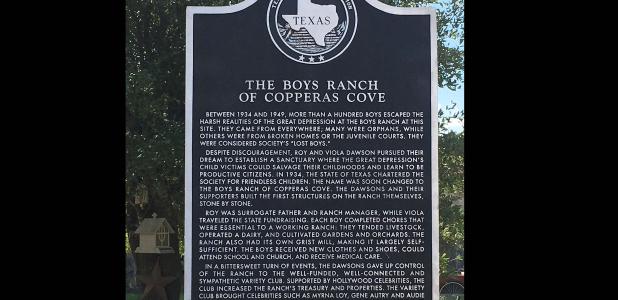Copperas Cove Boys Ranch recognized as state historical site
By DAVID J. HARDIN
Cove Leader-Press
During the height of the Great Depression, two people set out to change the lives of a group of boys who were poor, neglected, and left without a home.
Viola and Roy Dawson opened The Boys Ranch of Copperas Cove to these boys in 1934.
On Saturday, the Texas Historical Commission and the Bell County Historical Commission recognized the ranch as a place of historical significance during a ceremony at the Copperas Cove Public Library.
A Texas Historical Commission permanent marker now stands on the property of the former home for boys.
Viola Mae Roubison Dawson and her husband, Roy Ernest Dawson, purchased 502 acres of rolling landscape. The Dawsons’ opend a home that became a refuge for young boys who were homeless or who were always getting into trouble.
By 1940, 24 boys lived at the ranch full-time with the Dawsons, and by 1944, 35 boys lived at the Boys Ranch of Copperas Cove.
The Dawsons ran the ranch until 1944, and by that time had financial difficulty keeping the ranch going. A national charitable children’s organization, the Variety Club, then took over the ranch to run it until the ranch was closed in 1949.
Margaret Dawson Galloway is the oldest daughter of Viola and Roy Dawson. She spent years researching and talking with her father before his passing in 1984 and self-published a book in 2012 titled “Boys Ranch of Copperas Cove- A Home for Love and Hope.”
Since then, she has been working on trying to get a historical marker for the Boys Ranch of Copperas Cove, on Boys Ranch Road, which is now considered a part of Kempner.
“It was a lot of hard work and a labor of love. I retired in 2010, and then started working on the book and completed it in 2012. During that time, I was able to find some of the boys who lived at the ranch and got information from them that I was able to use in my book. I drove around a lot trying to gather everything that I could with regards to this Boys’ Ranch,” said Galloway. “My Aunt May Dawson had many records because she was alive when the ranch was still active. She let me look at a lot of pictures, and all of her records.
“I then found out that some very popular celebrities would come to the ranch and offer their support and entertain the boys like country singer Gene Autry, actress Myrna Loy, and actor Audie Murphy.
“The children of Boys Ranch came from anywhere and everywhere without regard to creed or background. Many were orphans including several sibling groups. Others came from broken homes with histories of extreme deprivation, both physical and emotional. Still others, who had been in minor scrapes with the law were taken from jails, juvenile courts, and reform schools. All had known deep sorrow and tragedy in their lives. They were children who felt that they were not wanted by anyone and some were labeled as born criminals. All were considered ‘lost boys’ to society.”
Galloway expressed her gratitude to Annabel Levesque, the current owner of the land where the Boys Ranch of Copperas Cove once was.
Galloway said she spent several years submitting her research with the Texas Historical Commission and received help from Patty Benoit with the Bell County Historical Commission.
“Each year the Texas Historical Commission only accepts 175 applications for an historical marker,” said Benoit. “Each application is accompanied with research, facts and testimony by the people who are involved, and you need to be able to prove the markers historical significance. It is a very difficult and lengthy process.”
Harold Millender lived at the ranch while he was growing up and was present with several of the former ranch “boys.”
“I think that it was a very special event. I think that it was nice that history is being remembered, and it is nice when someone who is not associated with the situation takes an interest in learning about our past,” Millender said.
Emmitt Herod is another boy who stayed at the ranch,
“It was a place to go and it meant a lot to us,” Herod said. “They took good care of us and because of that we are standing here today.”
Alton Brantley and his brother came to the ranch together.
“My father died when I was four, and I was one of four children who could not be cared for by our mother. Therefore, Viola and Roy took me and my brother in, and I did mostly farming when I got up into my teens. I was well cared for and for that I am grateful,” Brantley said.
Virgil Gribble, age 83, was another of the Boys Ranch residents who hoped to attend the ceremony. However, Gribble passed away on October 11, three days prior.
Carmen, his widow, along with their children came to the ceremony.
“It was history, and Virgil loved history. The world is about history, and if people want to know about history, then it is great when people want to learn about something like this,” Gribble said.
During the ceremony, Galloway also talked about her parents’ legacy which went beyond the ranch.
“Predicted to be a burden to society, most boys became productive citizens with families of their own,” Galloway said. “Many of the boys went on to fight for their country in World War II and Korea.”

